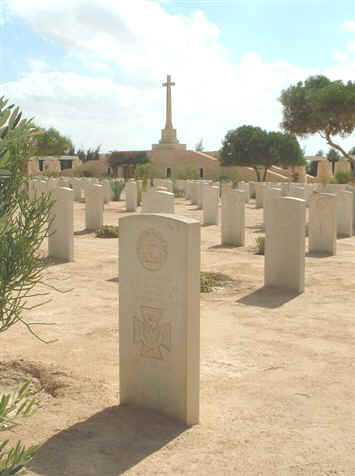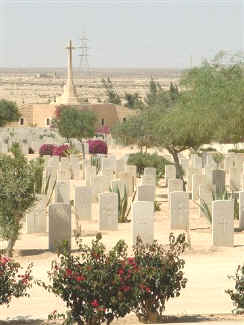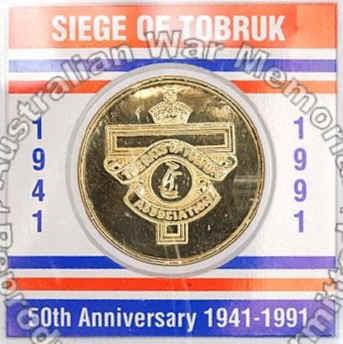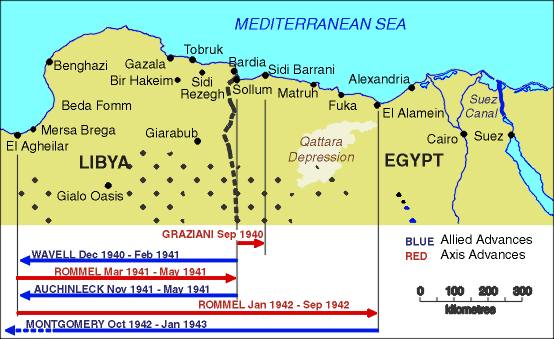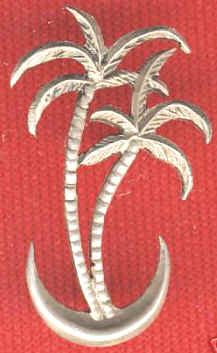|
In the weeks leading up to 9 December 1941, lighters and barges laden with
Australian troops slid silently from the battered waterfront of Tobruk. Not a
man of them spoke as the ghostly flotilla maneuvered to the sides of waiting
warships.
They were Australian troops being evacuated from the Tobruk garrison.
The
Australian garrison had been relieved after a siege of
more than 240 days during which the name of Tobruk had been written in
glowing colours in the annals of Australian courage and determination.
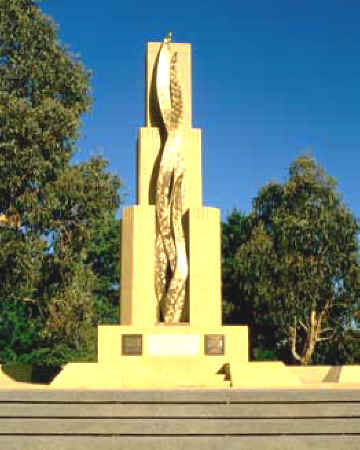 |
For eight months, with a ring of steel, the gallant AIF had barred the
advance of a hitherto all-conquering German Army.
In their fortress of dust and
death, they had carried the fight to the German flank, defying the most
intensive dive-bombing barrages in martial history.
News that the garrison had been relieved was received in Australia with joy,
but it was joy tinged with disappointment that the heroic band was not to have
the supreme reward of marching out to share the triumph of the Imperial troops
in their second drive across Libya.
|
| Rats of TOBRUK
Memorial Canberra |
The soil of Tobruk must be forever Australian. Australians, backed by British
artillery and tanks, captured the fortress in the first Allied drive through
Cyrenaica (Libya), and Australian troops, again backed by British artillery,
held it against as great odds as have been faced by any garrison in history. The
very dust of its bomb-pocked perimeter is hallowed with Australian blood, and
Australian dead lie in its windswept cemetery.
The story of the Tobruk garrison begins in April 1941 when the Germans,
striking with unexpected speed and mechanized strength, thrust the Imperial
Forces back from Benghazi and across the Cyrenaican plains to the Egyptian
frontier.
|
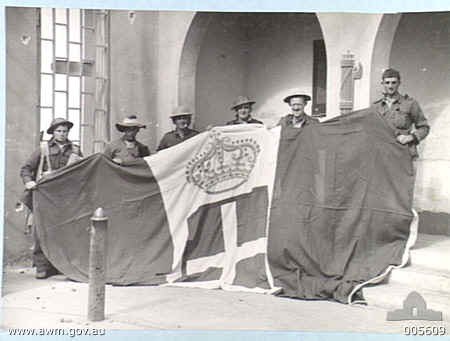
|
- The part of the story that sometimes gets lost in the
bigger saga of the Siege is the fact that Australians helped capture
Tobruk in the first place. They evicted Mussolini's "famous"
defenders with little trouble. This is the town's official flag,
liberated from the Town Hall.
|
Cut off from their main forces, the AIF fell
back on Tobruk, retired behind its strongly fortified perimeter and established
the ring of fire and steel on which successive waves of German shock troops were
shattered.
A big white town, with a peacetime population of about 5,000 people, Tobruk
lies at the end of a bay about one mile wide and two miles long. It was planned
and built as a garrison town, for there can be no other reason for its existence
in arid, treeless country supporting only a few camels, goats, and gazelles.
Through the town runs the single bitumen road that crosses Cyrenaica.
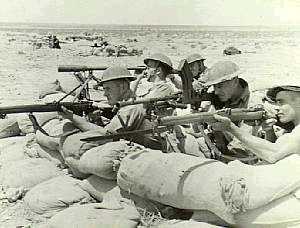 |
Men of the 2/13 Battalion
on the perimeter. Note the total absence of geographical high points.
The land was very flat in most cases. |
The ring of strong-posts which the Italians built around Tobruk is about 26
miles (45 kilometers) long. Each flank rests on the sea, and for three or four
miles (five to seven kilometers) from the coast the posts defending the flanks
are on the inner side of bare, precipitous wadis. Each strong-post is a
labyrinth of concrete-sided trenches and there are concrete emplacements for
anti-tank guns and machine-guns within the posts.
This, then, was the fortress town to which the AIF was to cling through the
heat in blinding sandstorms of a North African summer - a poisonous thorn in the
flank of the enemy.
The strategy of Major General L J Morshead, of the
Tobruk garrison, was simply this: to hold the town at all
costs, and, by offensive forays, to force the enemy to divert greatly
superior forces to hold a dangerous threat and thus weaken his drive against
Egypt.
It was in the heat and dust of Tobruk that Australian tenacity and courage
achieved its supreme expression. Air raids which had gone into the thousands
before unofficial statisticians lost count had no more effect on members of the
garrison than the enemy's artillery, strafing and attacks by tanks.
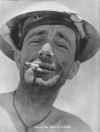 |
The siege was only a couple of months old when the renegade Lord Haw Haw,
broadcasting from Berlin, said they were "caught like
rats in a trap" and applied it to the garrison because most of its
men could find shelter only underground while the bombers were overhead. Our men
accepted the title with relish. To one another, they were "the rats."
To the Axis they were rats with razor-sharp teeth. They became "The
Rats of Tobruk"
|
In the first phases of the siege the Australian garrison, concerned primarily
with testing its strength, concentrated on defence. But as the troops proved
their ability to repel thrust upon thrust by Germans and Italians, defence gave
way to fierce aggression as the world's most daring patrol fighters went into
action each night.
Tobruk patrols were of two types - fighting and reconnaissance. The job of
the reconnaissance patrol was to gather information
and, if possible, to secure prisoners for identification. Its members used all
their bushcraft to avoid being discovered. Like
stealthy shadows, they saw without being seen. But the fighting
patrol went out to fight. Its aim was to do as much damage and to kill as
many of the enemy as possible. Its members would creep up
on an enemy post, surround it and then, at a given signal, rush in with the
bayonet and kill-soundlessly A few brief minutes of bloody,
sinew-straining work and the foray would be over, with not a shot fired.
So persistent and so deadly were the Australian night patrols that the enemy,
living in the perpetual shadow of silent, stealthy death, was soon reduced to a
state of almost panicky nervousness. On the slightest provocation, and often on
no provocation at all, he would put down artillery and mortar barrages.
Two typical examples of AIF offensive patrols are quoted. In the first, the
raiders crawled in single file for two miles through a minefield to attack an
observation post, the position of which had been revealed by reconnaissance
patrols on the previous day.
| The patrol started on its journey after midnight and was preparing for the
final assault when Very lights lit up the scene, and the enemy post opened fire
with rifles and machine guns. Five of our men then charged in with bayonets,
Tommy guns, and grenades. Despite a volley of hand grenades from the enemy, the
patrol stormed on, killing 15 and wounding many of the estimated 50 enemy before
crossfire from supporting posts forced a withdrawal. The patrol regained its own
lines, suffering only slight casualties.
The second classic patrol won for its leader, Lieutenant William. Horace
Noyes, the Military Cross. With an NCO, Lieutenant Noyes stalked
and destroyed three light tanks and led a bayonet attack against the enemy
garrison. His unit captured the post and killed or wounded the garrison of 130,
as well as the crews of seven machine-guns and 11 anti-tank guns and their
protective infantry. It also damaged a heavy tank.
|
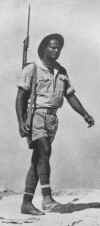 |
Throughout the siege the AIF garrison operated with a perfect team work that
ran from the front-line soldier, back through his immediate headquarters to the
artillery, back to the higher formations, to the supply and ordnance workshops,
and to the hospitals. In the entire garrison there was not one idle mouth to be
fed.
And throughout the eight bitter months of heat and dust and blood and flies,
the garrison retained those high spirits that are the hallmark of high courage.
If Lord Haw Haw thought he could goad the Australians with his bitter tilt at
the "Rats of Tobruk" he committed the
grossest of his many misjudgments.
The men were proud of the title and some of
them now treasure an unofficial medal, bearing the stamp of a rodent rampant,
which was unofficially struck to commemorate the defence of Tobruk. see below
left
That medal was fashioned from aluminum taken from the
fuselage of a German bomber brought down by the anti-aircraft fire of the
sharpest-teethed rats in history. Below right is a newer commemorative medal issued by
the Association in 1977
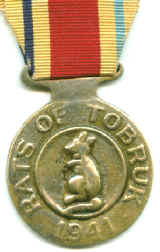 |
1st Rats of Tobruk medal
(copy)
|
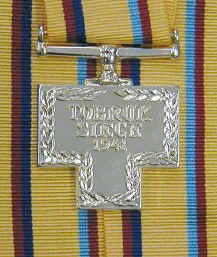 |
This
medal issued by the Rats of Tobruk Association. That makes it
un-official. It is however recognised.
The ribbon is khaki with light blue
and maroon stripes.
Tobruk Siege 1941 Medal
(unofficial) |
And so, after months of indomitable fighting, the "Verdun of the
Desert" was relieved and the British Navy's perfectly executed evacuation maneuver
wrote the final chapter of an epic that must always rank among the finest
achievements of Imperial arms.
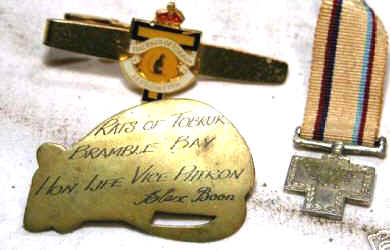
But there were some of that heroic band who could not answer the evacuation
order. Their release had come earlier. They lie in the little war cemetery near
the Bardia Road. A simple concrete memorial, about 25 feet (seven and a half meters)
high and of chaste design reminiscent of the Cenotaph, stands at the entrance.
Its only ornament is a cross and below is a marble slab bearing the words:
|
This is hallowed ground,
for here
lie those who died for their country.
At the going down of the sun,
and in the morning,
we will remember them.
|
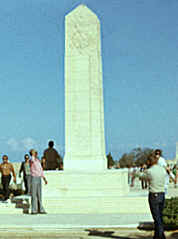 |
|

